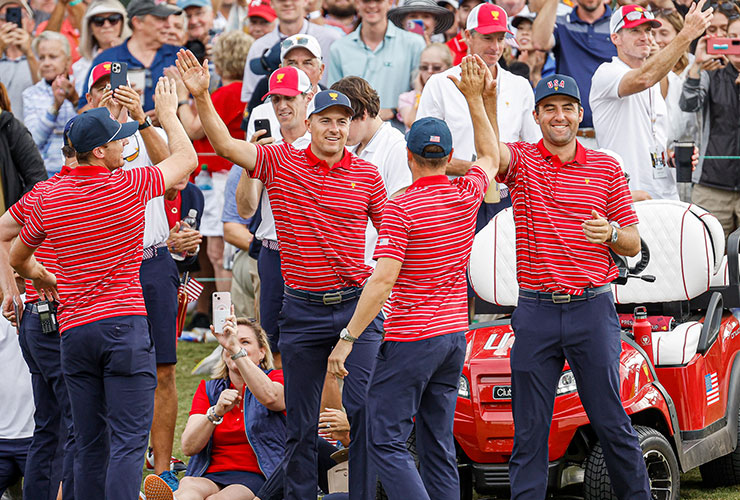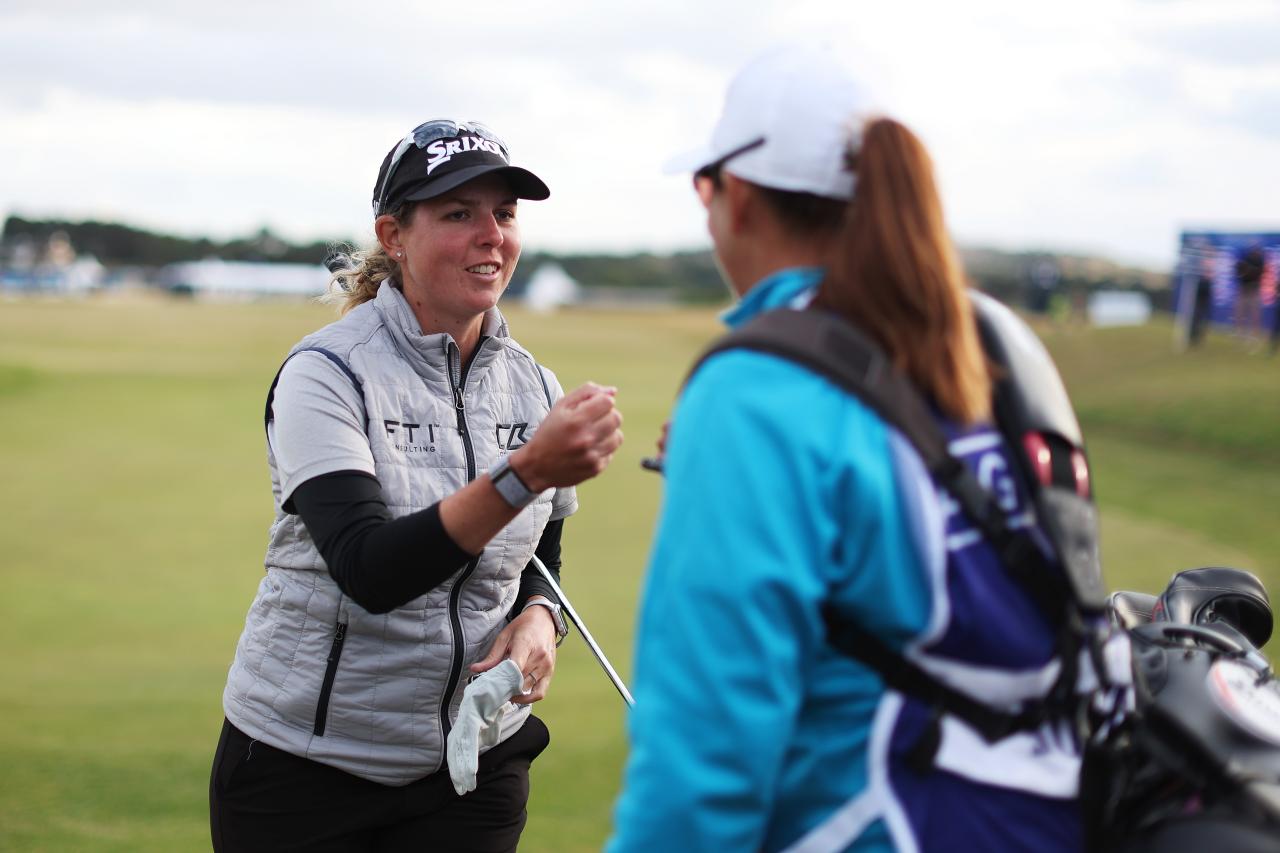Golf Digest Middle East counts down the top 25 players, events and moments of the year in golf
By GolfDigestME.com
Golf may be a niche sport, but in 2022, the game found its way into the mainstream, conversations sparked by two words: LIV Golf. The launch of the hotly debated circuit brought anticipation and consternation with every new detail, rumoured or real. Who would play, how would it work and what would it mean to have someone spend more than $750 million alone in 2022 (with another $1.25 billion expected in 2023) in a quest to redefine the professional game?
The answer to that last question is unknown as the ripple effects of 54-hole, no-cut, $25 million tournaments on golf’s ecosystem — competing tours, major championships, governing bodies, world rankings, etc — have only just begun. In the early wake, the game wrestles legal manoeuvres and esoteric observations about the value of tradition versus cash.
As we embark on our annual review of the year in golf, LIV will, of course, be an underlying thread in many of the top 25 Newsmakers that appear over the next several days. Rest assured, though, there were others on our list of favourite people, events and moments that helped define the year — stories of hope and heartache that help us all remember why we love the game.

No. 11: Cup Upheaval
In an alternate universe where COVID never forces the Ryder Cup onto an odd-year cycle, the PGA of America, which runs the Ryder Cup, would have been the first to confront an uncomfortable question: Should the organisation do a solid to the PGA Tour and risk damaging its headline revenue-generating event by prohibiting LIV Golf participants from being on the teams?
Instead, that burden fell on the Presidents Cup, set for September at Quail Hollow Club in Charlotte. Given the PGA Tour runs that match, it didn’t hesitate banning LIV golfers. For the US team, this was a largely incidental decision. All six automatic qualifiers were still card-carrying tour members, and there was no American plying his trade on LIV whose form would make an obvious captain’s pick for Davis Love III.
It was a different story for the International team and captain Trevor Immelman. Two of his top four players in automatic qualifying — Cameron Smith and Joaquin Niemann — took themselves out of the running when they moved to LIV after the Tour Championship in late August. Same with six-time PGA Tour Marc Leishman, who would’ve been an obvious captain’s pick. Suddenly, a team that had won just one time in 13 editions of the match looked like an even more under of underdogs.
To Immelman’s credit, the Internationals succeeded in making the contest more competitive than anticipated, the 17.5-12.5 final score betraying just how close things were during Sunday’s singles. Tom Kim rose as an unlikely hero, one of a trio of young South Korean players who emerged as potential anchors for Mike Weir when he captain’s the Internationals at Royal Montreal in 2024.
Even so, the weakness of an already flailing contest is plain for all to see. The International team hasn’t lifted the Presidents Cup since 1998, and to have several of its best players likely ineligible moving forward is a gutting blow. With LIV appealing specifically to the best International players, it’s hard to comprehend what the road back — if any — is.
The Ryder Cup, meanwhile, has the luxury of waiting to let things cool down and play out. The awkward removal of Europe’s original captain, Henrik Stenson, after he signed with LIV in July was a controversial call, one that even golf fans passively opposed to LIV considered harsh. But, ultimately, it’s a trade-off they’d take. There will be no uprising against Stenson’s replacement, nice guy Luke Donald.
The luxury it doesn’t enjoy is golf fans not caring what they decide to do. The Ryder Cup has stakes. Real stakes. Ones people as passionate about. Ones that depend on the allure of an outcome nobody can predict. — Luke Kerr-Dineen
[divider] [/divider]

No. 12: Tom Kim
Despite all the craziness that happened this past year, it’s possible golf fans will one day look back on 2022 as the year that Tom Kim arrived, much like 1996 is known for Tiger Woods’ “Hello, world.” Kim didn’t have quite as dramatic of an entrance — his big hello came with a final-round 61 in Greensboro that more than erased a quadruple-bogey to start the tournament — but his stellar play put him off to the best professional start on the PGA Tour since his idol 26 years ago.
More incredible was that Kim began the year outside the top 130 in the Official World Golf Ranking and with no status on the PGA Tour. But a third-place finish at the Scottish Open coupled with solid performances at the US Open and Open Championship earned him special temporary membership for the rest of the season and, boy, did he take advantage of that. By winning both the Wyndham Championship in August and Shriners Children’s Open in October, Kim became the first player since Tiger to win twice on the PGA Tour before turning 21. And young Tom, now in the top 15 of the OWGR, doesn’t turn 21 until summer. There’s also more to this South Korean phenom than his game as proved at the Presidents Cup, where he was the breakout star in September at Quail Hollow despite playing on the losing International squad. The guy who takes his English name from the “Thomas the Tank Engine” cartoons he enjoyed as a kid is a plucky locomotive in his own right. And if this is just him leaving the station, golf fans are in for a real treat watching the rest of his journey unfold. — Alex Myers
[divider] [/divider]
No. 13: PGA Championship
There was no lack of drama during last May’s PGA Championship, even if nothing was quite as it appeared at Southern Hills Country Club in chilly(!) Oklahoma. The winner, Justin Thomas, in a playoff over Will Zalatoris, started the final round seven shots off the lead. The leader heading to the 72nd hole, Mito Pereira, finished in a tie for third when his final tee shot found water. Tiger Woods, competing in just his second official tournament since his February 2021 car accident, made the cut but didn’t play the final round, his surgically repaired right leg not cooperating. Bubba Watson shot a Friday 63 despite two bogeys. Maybe this was all to be expected considering the championship wasn’t supposed to be in Tulsa. Recall that the 2022 PGA was originally awarded to Trump Bedminster in New Jersey only for the PGA of America to take it away after supporters of President Trump stormed the US Capitol on January 6, 2021. The last time Southern Hills hosted the PGA was in 2007, when temperatures hovered in the high 90s. Come the weekend this time around, the thermometer was stuck in the 60s. In turn, the Gil Hanse restoration proved a stiff test for the leaders come Sunday’s final round, which allowed Thomas, a then 14-time PGA Tour winner but winless in 13 months, to work his way to the top of the leaderboard with four birdies on the last 10 holes for a closing 67. Finished at five under, the 29-year-old saw Pereira make double-bogey on the 18th to drop to four-under, but Zalatoris roll in an eight-footer for par to force the three-hole aggregate playoff. Thomas prevailed, capturing his second major and matching the largest 54-hole comeback in PGA Championship history. Nine days later, LIV Golf announced the opening field for its inaugural event. — Ryan Herrington
[divider] [/divider]
No. 14: Matt Fitzpatrick
All the way back in 2015, roughly 18 months after earning low amateur honors at the Open Championship then winning the U.S. Amateur, Matt Fitzpatrick acknowledged a stark reality: to make it as a professional golfer the slightly built Englishman would have to increase the length of his average drives beyond the “around 280 yards” he was currently hitting.
“I understand how massive an advantage distance is these days,” he said. “If I want to get to the very top, I will have to get longer.”
He did. But not by enough. Not in his own mind at least. Yes, he was starting to win regular tournaments and play in Ryder Cups, but competing at the very highest level seemed beyond him. Although his average drive was up to 294.7 yards by the end of the 2019-20 PGA Tour campaign, that figure ranked him only a lowly 121st.
Making things more urgent was Bryson DeChambeau’s overpowering 2020 US Open victory at Winged Foot. Fitzpatrick wasn’t happy with what he witnessed (“It just makes a bit of a mockery of the game. It doesn’t matter if I play my best. He’s going to be 50 yards in front of me off the tee.”) but knew what had to happen next.
The search continued, one that culminated with Fitzpatrick adopting a training program involving the Stack System, a club that uses a collection of weights developed by a human kinetics professor from Canada. Since 2019, his swing speed has increased by almost four miles per hour and his percentage of 320-yard drives has tripled to 15.22. This year his average drive rose to 303.8-yards, good enough to be 70th on tour.
So in 2022, Fitzpatrick was, at last, long enough to compete at the highest level of the game, a fact confirmed by placement in the final group at the PGA Championship at Southern Hills in May, then his memorable victory a month later in the U.S. Open at The Country Club, the same course where he won the Havemeyer Trophy in 2013.
“I’ve hit a few good drives this year and expected to see them come down in certain places,” Fitzpatrick said. “But they’ve gone past that.”
Perhaps just as significantly for the 28-year-old’s future, Fitzpatrick is also getting better in other areas of the game. Through his use of a distinctive left-hand-low grip, his work around the greens has been transformed. Throw in Fitzpatrick’s exceptional putting — always a strength — and it is little wonder that his swing coach, Mike Walker, was making positive noises for 2023 and beyond.
“We just had the end-of-season review,” Walker said. “Matt’s stats in pretty much everything have improved. He’s a great pupil, very single-minded. He’s not one for ‘if it’s not broke don’t fix it.’ He always wants to improve. And he is doing so. The driving was exceptional for added length. But in that pursuit, he also retained his accuracy. His chipping was considerably better with the new grip. And he remains a phenomenal putter, albeit he did have a couple of blips last year. So the end-of-year school report was good, both for effort and attainment.” By a distance, you might say. — John Huggan
[divider] [/divider]
No. 15: Lydia Ko
First, she was a teen phenom. Then a maturing superstar hampered by success. But in 2022, Lydia Ko staged a third act in her impressive career, emerging as a confident veteran playing the game on her own terms. The 25-year-old from New Zealand won three times (her first multi-win season since 2016), capped by the CME Group Tour Championship. That victory, her 19th on the LPGA Tour, came with the biggest winner’s check in the history of women’s golf: $2 million. Ko posted top-five finishes nine other times. She won Player of the Year for a second time and a second Vare Trophy (for best scoring average). She led the tour in strokes gained/total and putting. She put herself within two wins (or one more major) of securing a spot in the LPGA Hall of Fame. Look, we get that Ko has had some amazing years in the past — who can forget those five wins (including a major) and the POY award she earned in 2015? Or the four wins (including another major) in 2016? But don’t tell us 2022 wasn’t the best season of her career. (Did we mention, she got back to No. 1 in the world for the first time since 2017?) “There’s been a lot of ups and downs, both on and off the golf course,” said Ko, who is set to get married in the offseason. “And I think yes, maybe when I was younger, I played a bit more freely because I was a little clueless. At the same time … my perspective and how I treat the bad shots or the bad events a lot better now than I did then.” Sure, her early years were enthralling. But this next era of Ko is the one we’re most excited for. — Keely Levins
[divider] [/divider]
No. 16: US Adaptive Open
A stroll behind the competitors on the driving range at Pinehurst Resort & Country Club’s No. 6 course last July made one point very clear: This would be a tournament unlike any other in the history of the USGA. There was a vivacious woman wearing bright colors whose legs were amputated above the knee. There was a man with only one leg who dropped his crutches to balance beautifully and make an impressive strike of his ball. There was a young woman whose sight had been reduced to a kaleidoscope of color, her father talking her through every shot. There were men and women with less obvious issues — their impairments came not in their bodies, but their brains.
Since the announcement of the inaugural US Adaptive Open, there had been curiosity, and even a little apprehension, about what it might look and feel like to see 96 golfers with varying forms of adaptions perform on a stage as big as the USGA provides. In the end, the competition morphed into a three-day celebration of opportunity, diversity and unfathomable grit. It was, for so many, the most inspiring golf they had ever witnessed.
“I’ll be honest,” USGA CEO Mike Whan told Golf Digest on the final day of competition. “I’ve come off a year of LIV questions and purse increases and TV deals, and you realise when you’re out here … how much more this is really what golf is, and that other stuff is just that other stuff. … I think a lot of times we get so caught up in one per cent, we forget about the real people who make up this game.”
The golfers — the youngest at 15 and the oldest at 80 — came from around the world to compete in eight impairment categories. The top male and female finishers in each of the divisions earned a copper medal, and two overall champions lifted the Adaptive Open men’s and women’s trophies for the first time. Simon Lee, a 25-year-old who is on the autism spectrum, impressively carded a three-under total over 54 holes and prevailed in a two-hole playoff over another golfer with an intellectual disability, Sweden’s Felix Norman. And 41-year-old Kim Moore, a lower-leg amputee who is the women’s golf coach at Western Michigan, romped to an eight-shot win among the women with a 16-over total.
Being the first staging, there were some operational wrinkles to be worked out, and there will no doubt be some alterations when the championship returns to Pinehurst in 2023. But the whole week was summed up beautifully by a joyful Lee: “This is like a dream.” — Tod Leonard
[divider] [/divider]
No. 17: Sahith Theegala
Sahith Theegala began the year well outside the top 300 in the World Ranking. He’ll end it well, well inside — 44th as of this week. The 25-year-old from Orange, California, was college golf’s consensus player of the year coming out of Pepperdine in 2020, but because his professional debut came in the midst of a pandemic, Theegala began his career on the Outlaw Tour. After proving his merits on the mini-circuits and earning his PGA Tour card for the 2021-22 campaign, Theegala showed why he was such a highly touted amateur in his rookie season. First there was his near miss at the Waste Management Phoenix Open in February, a frenetic T-3 finish to then first-time winner Scottie Scheffler after a bogey on the penultimate hole — punctuated by an emotional post-round embrace from his parents. Four months later at the Travelers Championship, he again had victory in his grasp before an ill-timed bunker shot on the 18th did him in. The close calls helped him earn an invite to the season-finale Tour Championship. “I think the validation of the season, it’s another step for me to feel like I really belong because I still don’t feel like I’m really there at the top of the game,” Theegala said at the BMW Championship after securing his spot at East Lake. “Slowly building confidence every week, whether it’s a good or bad week. I feel like I’ve made a lot of progress.” Theegala backed those words up with three top-six finishes in six fall starts, highlighted by a T-2 at the RSM Classic. But what makes Theegala, whose parents were born in India, a newsmaker is not just his game but his magnetism, owning an affable, approachable personality and a cerebral, introspective mindset while displaying a gratitude not normally seen at this level. In short, the type of person, and player, that can be a bonafide star. This year brought a lot of questions regarding the future of golf, but if Theegala is a part of it, the game will be in good hands. — Joel Beall
[divider] [/divider]
No. 18: LPGA major purses
Golf’s prize money payouts have long been a source of curiosity and conversation, but in 2022, the discussion grew far louder (and more heated) with LIV Golf arriving and adding an extra zero to what had been “normal” purses. The funny money thrown around in the men’s game overshadowed the impressive gains separately witnessed in women’s game, where pleas for better paydays for the best female golfers in the world were finally answered. The USGA set the tone in January when it announced the U.S. Women’s Open purse had been elevated from $5.5 million to $10 million in 2022 — a 81.8-per cent increase thanks bringing on presenting sponsor ProMedica. (Minjee Lee, above, won the title at Pine Needles, and $1.8 million first prize while USGA CEO Mike Whan also committed to the purse moving up to $11 million and then $12 million in the next five years.) Subsequently, the other women’s majors followed suit. Chevron, taking over ANA’s sponsorship of the first major of the year, boosted the purse from $3 million to $5 million. The KPMG Women’s PGA Championship doubled its prize money payout, awarding $9 million to the field. The Amundi Evian Championship saw $2 million in growth, lifting the purse to $6.5 million. The AIG Women’s Open went from $5.8 million to $7.3 million. All told, the majors offered $37.8 million in prize money payouts compared to $13.65 million 10 years earlier. And though the CME Group Tour Championship is not a major, it, too, increased its purse and awarded the biggest first-place check in women’s golf history: $2 million going to winner Lydia Ko in the season finale. The trend continues next year, as the LPGA announced for the first time in history, the tour will compete for more than $100 million in total purse money in 2023 (up from $75 million in 2021). Playing on the LPGA is serious competition; it’s good to see the money get serious, too. — Keely Levins
[divider] [/divider]

No. 19: Misha Golod
When Russia began its invasion of Ukraine, one of the best golfers in Eastern Europe found himself in the middle of a war zone. Weeks after winning back-to-back amateur events in Turkey, 15-year-old Mykhailo “Misha” Golod phoned Golf Digest from his home in Kyiv in the midst of aerial bombardment, trying to convey the horrors that were just outside his window. “We hear, it seems like, 50 explosions a day,” Golod said. “You never know where they are, but they always sound close. The air sirens, letting us know something is coming, are always blaring.” Golod’s story, like many that came out of Ukraine, was heartbreaking. However, the golf community found a way to help its own. Thanks to golf instructor David Leadbetter and Global Golf Post founder and American Junior Golf Association board member Jim Nugent, Golod was able to get out of the country and find refuge in Orlando at Leadbetter’s golf academy. “You read what’s going on over in Ukraine, and it’s just terrible. You feel so helpless, and it doesn’t feel like you can really do anything at this moment,” Leadbetter said. “Then we saw Misha’s story and realized, ‘Well, maybe there is something we can do.’” The 2021 Ukraine Open Junior champion arrived in the United States a week after his interview in March and became a bit of a media sensation, attending the Players Championship and Masters as a guest. Golod’s parents are still living in Ukraine and he maintains regular contact, but he has resumed his golf career, winning a number of prestigious amateur tournaments since his arrival. And though the atrocities of the Russian war continue, Golod’s tale underlines the hope that exists even in the face of evil, and the power that golf can have to do good. — Joel Beall
[divider] [/divider]
No. 20: Netflix jumps into golf
The success or failure of the upcoming, still-untitled Netflix documentary on the year in professional golf will inevitably be compared to the breakout hit “Formula 1: Drive To Survive,” which transformed how the world saw F1 racing. It will be tempting, in fact, to believe that it was “Drive to Survive” that was the direct inspiration. In fact, Chad Mumm, the chief creative officer at Vox, dreamed of making a golf-themed show since at least 2014, when, as the head of Vox’s ad agency, he lost out to Skratch in a bid to work with the PGA Tour. Having maintained his relationship with the tour’s media team — they played golf together each year in Las Vegas at a tech conference — he finally got his shot in 2019. By that spring, it was starting to become clear what Netflix had on its hands with DTS, and even if it didn’t necessarily assist with Mumm’s initial pitch, it helped with everything that came after, from signing players to securing Netflix as the platform of choice.
With the first audio recorded at Tiger’s Hero World Challenge in December 2021, and shooting starting the week of Torrey Pines in 2022, Mumm’s teams have been behind the scenes, chronicling a year in professional golf, whatever that might entail (and in 2022, it involved more than they ever expected). Among the “cast” of signed players are Rickie Fowler, Brooks Koepka, Ian Poulter, Tony Finau, Matt Fitzpatrick, Scottie Scheffler, Justin Thomas, Mito Pereira, Joel Dahmen, Max Homa and Sahith Theegala.
The biggest “character” of all, though, might be the one they weren’t expecting: LIV Golf. Whether the division in the sport is good for the game is up for debate, but controversy and drama of that type is never bad for a film crew, and in that sense the Netflix team couldn’t have picked a better year to start its project.
What’s to come is an eight-episode series that debuts on February 15, and if it reaches anywhere near the dizzying heights of DTS, it will be a coup not just for Vox and Netflix, but for all the stars of the show and the sport of golf itself. A few years ago, it might have sounded hyperbolic to say that a simple documentary could transform an institution like golf. Now, we’ve seen what it can do for a niché sport, and we know that the so-called Netflix Effect could be seismic. — Shane Ryan
[divider] [/divider]
No. 21: Patrick Reed’s lawsuits
It wasn’t the most productive season of Patrick Reed’s career on the course — he fell out of the top 50 in the World Ranking for the first time since January 2014 — but when it comes to taking people to court, it was a downright historic year for the 2018 Masters champ. In August, Reed filed a $750 million civil lawsuit in US District Court in Houston against Golf Channel and Brandel Chamblee alleging the defendants conspired with the PGA Tour to defame him by misreporting information “with falsity and/or reckless disregard for the truth.” Reed subsequently withdrew the case and refiled it in September in a District Court in Florida, adding Golf Channel broadcasters Shane Bacon, Damon Hack and Eamon Lynch, as well as their media companies Golfweek and Gannett. In November, Reed filed another defamation suit, this one for $250 million, against Fox Sports, the New York Post, Hachette Book Group and the Associated Press, as well as author Shane Ryan and AP journalist Doug Ferguson. That’s $1 BILLION in damages being sought by the nine-time PGA Tour winner, who managed to earn more than $12 million playing for the 4 Aces after moving from the PGA Tour to LIV in June. A judge dismissed Reed’s initial complaint against Golf Channel and Chamblee in November, requiring him to file an amended one this month. — Alex Myers
[divider] [/divider]
No. 22: Oakland Hills clubhouse fire
Up from the ashes sounds like a nice slogan or battle cry, but those words ring differently to the members of Oakland Hills Country Club. Because they are living them. Disaster struck the historic facility north of Detroit in Bloomfield Township, Michigan, Febebruary 17 when its sprawling neo-colonial clubhouse — the second-largest wooden structure in the state after the iconic Grand Hotel on Mackinac Island — went up in flames, causing damage estimated at $80 million. But only a few weeks later, the USGA announced a 29-year strategic partnership with Oakland Hills that will bring eight championships to the recently renovated South Course, the so-called “Monster” as Ben Hogan referred to it after winning the 1951 US Open. “This is a testament to our relationship with Oakland Hills and the incredible history that we share together,” said John Bodenhamer, USGA chief championships officer, who called Oakland Hills, one of the “cathedrals of golf.” Rightfully so, with a heritage that includes six US Opens, three PGA Championships and the 2004 Ryder Cup. The club intends to rebuild the clubhouse to replicate the exterior but install a new interior floor plan. Completion initially is slated for late 2025, not in time for its first USGA event in the new deal, the ‘24 U.S. Junior. Part of its past might have been erased in that fire, but the future looks bright. Flames can’t destroy a rock-solid reputation. — Dave Shedloski
[divider] [/divider]

No. 23: Steven Alker
When the PGA Tour Champions was finding its footing in the 1980s and early 1990s, it carried the reputation as a “second chance” tour, a place where club pros and journeyman might find some magic that, for whatever reason, eluded them before the age of 50. In that sense, Steven Alker is a throwback to an earlier era. During his career, the New Zealand native made 86 PGA Tour starts, missing the cut 47 times and never finishing inside the top 10. He also played in 80 DP World Tour events, missing 42 cuts while grabbing one top-10. Yes, he was a four-time winner on the Korn Ferry Tour, but there was a reason why Alker had to Monday qualify to play in his first senior tour event 16 months ago. Impressively, he turned that start — a T-7 at the Boeing Classic — into a run of six straight top-10 finishes culminating in a victory and a tour card. With job security brewed confidence, and suddenly Alker was unstoppable. In his first nine starts of 2022, he claimed three wins and seven top-fives — including a major (the Senior PGA Championship). Another title game in October, one of nine more top-fives in his last 14 starts, and he cruised to the season-long Schwab Cup title, only the third time a player other than Bernhard Langer had won it in eight years. Alker’s numbers are shocking in that they’re so unexpected. He finished 2022 with a 68.2 average in 75 rounds and earned $4.5 million, nearly four times his winnings on the PGA Tour and DP World Tour combined. “Just a lot of hard yards,” Alker said the secret to his success. “You know, I’ve played everywhere and I think that kind of helped today in a way just playing the PGA Tour and Australasia and Asia and Korn Ferry. It’s been an amazing journey and just to be here and to have this opportunity has been amazing.” —Ryan Herrington
[divider] [/divider]
No. 24: The LPGA’s breakthrough veterans
On the LPGA Tour in 2022, we saw the promise of youth in a 14-year-old Monday qualifying for three straight events and a 19-year-old climbing to World No. 1. But we also saw the joy that comes when patience is rewarded in a trio of veterans pulling off their long-awaited maiden victories.
First was Ashleigh Buhai. The South African was a teen phenom growing up, winning four professional tournaments as an amateur. But since arriving on the LPGA Tour in 2008, she had gone winless. That is, until the Women’s Open in August. During a historic week in which the formerly all-male Honourable Company of Edinburgh Golfers hosted the top women’s professionals to Muirfield for the first time, Buhai, 33, was impressively running away with the title, only to make a triple-bogey on 15 and question if this would be her time or not. She limped into a playoff with In Gee Chun, but on the fourth extra hole in a race against nightfall, Buhai pulled out the sentimental victory.
Buhai’s maiden win seemed to prove inspirational. Paula Reto also grew up in South Africa before moving to the US and finding golf as a teenager. The 32-year-old had played 157 LPGA events without a win until she finally broke through three weeks after Buhai at the CP Women’s Open, beating Hye-Jin Choi and Nelly Korda by a shot. A few weeks before the tournament, Reto lost her golf bag while travelling. During the wait for its return, she pulled out an old putter and found the more upright set-up helped her see lines on greens better. Clearly, the change paid off.
Going 157 starts until claiming win No. 1 was nothing compared to Jodi Ewart Shadoff’s 246-event wait. A three-time European Solheim Cup team member and runner-up in the 2017 Women’s Open, Ewart Shadoff hadn’t won in more than a decade on tour. In 2021, the 34-year-old Englishwoman had missed more cuts than she made. But at the LPGA Mediheal Championship in October, she finally hoisted her first LPGA trophy.
“I didn’t know if this moment would ever come,” Ewart Shadoff said through tears, echoing the sentiment of Buhai and Reto before her. Their waits were long, but ultimately worth it. —Keely Levins
[divider] [/divider]

No. 25: Morgan Hoffmann
If Morgan Hoffmann’s name had slipped your mind, you’re not alone. After revealing the atrophy he was suffering from in his right pectoral muscle was caused by muscular dystrophy in December 2017, the 33-year-old former All-American at Oklahoma State hadn’t played on the PGA Tour since October 2019. Presumably, he was undergoing treatments for his illness, and indeed that was the case, but in ways that shocked many in and out of the golf world. In January, Hoffmann revealed to Golf Digest that he had moved to Costa Rica with his wife Chelsea in search for a cure to the illness. Among the remedies Hoffmann attempted were ayahuasca treatments. The story noted that Hoffmann was still in the midst of a medical exemption that dated back to 2018, but that he had only three events remaining, and per tour rules, they had to be played in 2022 or else they would be lost opportunities. So in April, Hoffmann made the trek from Costa Rica to the RBC Heritage in Hilton Head, shooting a respectable 71-72 in his return to competition at Harbour Town but missing the cut. There was another early exit three weeks later at the Wells Fargo Championship, but in his last start at the Travelers Championship in June, Hoffmann made the cut but failed to earn enough money with the 68th-place finish to give him a tour card for 2023. Hoffmann later earned sponsor’s exemptions into the John Deere Classic (T-51) and the Rocket Mortgage Classic (MC), but he has not played since shooting 71-71 in Detroit in late July. What now for Hoffmann? Various interview requests from different media outlets have been made and several officials from the PGA Tour have attempted to contact him over the past few weeks, but they have all been unsuccessful. It is not clear where Hoffmann is currently living or what his plans are for competing next year. —Jay Coffin
You may also like:
Get the December 2022 edition of Golf Digest Middle East FREE here!
Scott Vincent earns LIV Golf 2023 ticket
Scottie chips in on OWGR situation
Sergio fires back at Tiger and Rory
LIV Golf unveils three new venues for 2023
Lee Westwood’s son to make pro debut
Seventh Saudi Open set to get rolling
Ernie Els targets silverware in Indonesia
Sibling rivalry at Australian open
Tiger: I would never take a cart on PGA Tour
Tiger Woods: Greg has to go
OWGR is flawed, says Tiger
LIV Golf reveal their World Cup XI
Hero Cup line-ups announced for Ryder Cup warm-up event in Abu Dhabi
Cam Smith aims to end career-best year on a high
Is it time to abolish OWGR?
Tiger out of Hero World Challenge
Sergio’s run comes to an end
Rory thinks he gave Tiger Covid ahead of the Open
Hedwall claims Open de Espana in dramatic fashion
Emotional triumph for Cam Smith in Australia
Meet Dan Bradbury, DP World Tour’s newest surprise package















